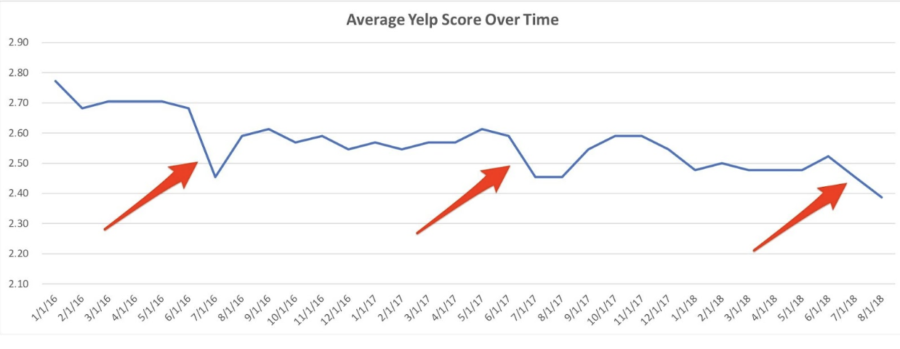Table of Contents
At Go Fish Digital, we see a lot of multi-location businesses that need help making review improvements. Goals range from increasing the overall number of positive reviews to hitting a star rating benchmark across all locations, to even scraping review text for trends and customer pain points.
Recently, we wanted to study a type of business that could stand to revamp its review strategy – gyms. Yelp reports that 10% of all its reviewed businesses fit into the Beauty and Fitness category, 4th most of all industries. Gyms and health clubs depend on reviews to help potential customers make what is sometimes a big financial decision. Digging into the numbers, we found three unique characteristics that gym owners need to acknowledge and leverage to separate themselves in such a competitive space.
Related Content:
- Online Reputation Management
- Online Reviews Management
- Search Suppression Services
- Yelp Review Management
For this exercise, we selected five well-known gym franchises and pulled Yelp data from some of their locations across the country. In total, we studied the data from 111 Yelp pages. Here’s what we found.
Review Removal Opportunities
Something that sets Go Fish Digital apart is our knowledge of Yelp’s review guidelines and how we use that expertise to help our clients flag and remove negative reviews. On average, these gyms had 76 reviews contributing to their overall star rating. Using our Yelp Calculator, we found that many of the locations were close to a tipping point, or spot where their score could be bumped up to the next-highest star rating (Yelp rounds up scores in half-star increments).
We found 13 locations that would move up a half-star rating if just one 1-star review was removed. In total, 37 locations, or 33% of the gyms we studied, could be improved with three or fewer 1-star reviews removed.
According to Yelp’s publicly available data, 7% of all reviews have been removed for violating Yelp’s guidelines. With the number of gym reviews that do not offer a relevant or firsthand experience, we believe this is an untapped improvement opportunity. For franchises looking to improve their highly-visible star ratings, that is low-hanging fruit to start addressing.
Summer Slump?
At the top of each Yelp page, viewers have the option to see a backlog of the business’ overall scores over time. By pulling this information and stringing it together, we can get an average trendline for these gyms.
We expected to see some type of fluctuation around New Year’s each season. It makes sense, right? New Year’s resolution season can make or break a gyms’ year, so they focus a lot of resources on promotional efforts to bring in new members and keep them the rest of the year.
But that’s not what we saw when we charted out the data. What this graph does show is three very distinct dips in the average, each drop occurring during the summer months and rebounding in the fall. Could it be that a larger number of members are flocking to the gym for bathing suit season? Is there a delay in attendance following New Year’s sign ups? Whatever the case, it looks like the late spring/early summer needs to be a point of focus for gyms’ customer service and review response teams.
Inverse Review Distribution
In our experience, the vast majority of businesses with multiple locations have an overall review distribution in the shape of an upside-down bell curve: lots of reviews with one and five stars, some fours, and very few twos and threes. Yelp data backs this up. If a customer is feeling motivated to leave a review, they’re likely passionate one way or the other.
However, the sample of gym reviews we pulled show a different distribution. Look at the amount of 1 and 5-stars in our sample’s review distribution vs. Yelp’s site-wide distribution. The percentage of 1-star reviews is double the normal distribution, while the number of 5-stars is half the typical amount.
Even in a small sample, that’s a glaring disparity. The average rating for our sample of gyms was about 2.4 stars, so it’s no surprise to see that many negative reviews. Looking at the content of some reviews, issues like overcrowding, cleanliness and customer service are definitely factors that seem to swing reviewer sentiment to one extreme or another. But the presence of that many 1-star reviews presents an opportunity. Perhaps more than most industries, gyms need to have a plan in place for responding to new reviews, flagging and soliciting new reviews.
Improvement Strategies
Gyms don’t have to go outside Yelp’s policies to make improvements to their online reviews. While there are unique industry challenges, franchise gyms have a great setup for improving their reviews. There is both regional and national oversight to identify review trends, the managerial staff at each location to respond promptly to reviews, and ample member data at their disposal. With the proper monitoring and strategies in place, gyms can make sizeable competitive gains in the online review space.
Search News Straight To Your Inbox
*Required
Join thousands of marketers to get the best search news in under 5 minutes. Get resources, tips and more with The Splash newsletter:



